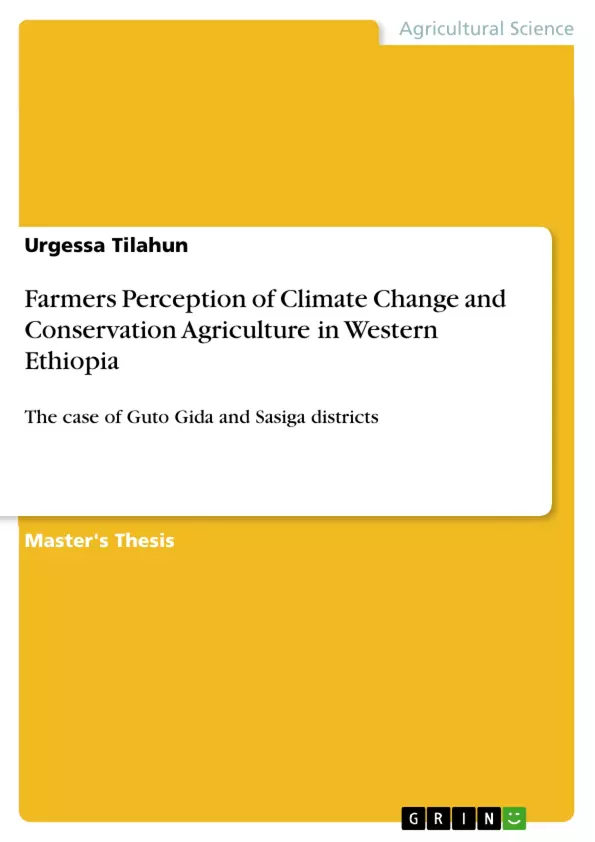Climate is a primary determinant of agricultural productivity. Ethiopia, one of the developing countries, is facing serious natural resource degradation problems. Adaptation strategies for environmental conservation require cooperation and local participation in environmental rehabilitation which in turn requires examining the local peoples’ willingness, beliefs, knowledge, attitude, interest and perception about climate change and conservation agriculture. The main objective of this study was to examine the farmer’s perceptions and adaptation to climate change and participation in conservation agriculture. The data used for the study were collected from 142 farm households heads drawn from the five kebeles of Sasiga district and four kebeles of Guto Gida district. Primary data were collected using a structured questionnaire. In addition, secondary data were extracted from relevant sources to supplement the data obtained from the survey.
In addition to descriptive statistics such as mean, standard deviation and percentages used, Heckman two stage sample selection model was employed to examine farmer’s perceptions and adaptations of climate change. Farmers level of education, household nonfarm income, livestock ownership, extension on crop and livestock, households credit availability, temperature and precipitation were those variables which significantly affect the adaptation to climate change. Similarly, the farmers perception of climate change was affected significantly by information on climate, farmer to farmer extension, local agro -ecology, number of relatives in development group and perception of change in duration of season. A binary logit model was employed to analyze determinants of farmers’ participation in conservation agriculture. Education level of the household head, number active family labour and main employment of the household head were significant variables in determining participation in conservation agriculture.
Based on the results obtained, the following points were found to be of paramount importance: the government and policy makers should encourage the way farmers get extension on crop and livestock than ever in order to increase the farmer’s adaptability to climate change. Perceiving the occurrence of climate change is prerequisite to adapt to the change. So, the government, policy makers, and NGOs should focus on the experience sharing between household farmers through conducting farmer to farmer extension.
Inhaltsverzeichnis (Table of Contents)
- Introduction
- Literature Review
- Methodology
- Result and Discussion
- Conclusion and Recommendation
- References
Zielsetzung und Themenschwerpunkte (Objectives and Key Themes)
This thesis examines the perception of climate change and conservation agriculture among farmers in Guto Gida and Sasiga districts in Western Ethiopia. The study seeks to understand the extent to which farmers are aware of climate change and its impacts, their adaptation strategies, and their adoption of conservation agriculture practices.
- Farmers' perception of climate change
- Impacts of climate change on agricultural production
- Adaptation strategies employed by farmers
- Adoption of conservation agriculture practices
- Factors influencing farmers' decisions regarding climate change adaptation and conservation agriculture
Zusammenfassung der Kapitel (Chapter Summaries)
- Introduction: This chapter provides a background on climate change, its impacts on agriculture, and the importance of conservation agriculture in mitigating these impacts. It also outlines the research objectives, study area, and methodology used in the study.
- Literature Review: This chapter examines existing literature on climate change, conservation agriculture, and farmers' perceptions of these issues. It explores the challenges and opportunities associated with climate change adaptation and the role of conservation agriculture in addressing these challenges.
- Methodology: This chapter describes the research design, data collection methods, and data analysis techniques employed in the study. It provides details about the study population, sampling techniques, data collection instruments, and statistical analyses used.
- Result and Discussion: This chapter presents the findings of the study, analyzing the data collected on farmers' perceptions of climate change, their adaptation strategies, and their adoption of conservation agriculture practices. The chapter discusses the key findings and their implications for agricultural development in the study area.
Schlüsselwörter (Keywords)
Climate change, conservation agriculture, farmers' perception, adaptation strategies, agricultural production, Western Ethiopia, Guto Gida, Sasiga.
- Quote paper
- Urgessa Tilahun (Author), 2013, Farmers Perception of Climate Change and Conservation Agriculture in Western Ethiopia, Munich, GRIN Verlag, https://www.grin.com/document/294030



